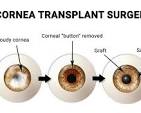Cornea Transplant: A Sight-Saving Procedure
A cornea transplant, also known as keratoplasty, is a surgical procedure that replaces a damaged or diseased cornea with a healthy donor cornea. The cornea is the clear, dome-shaped surface that covers the front of the eye and plays a crucial role in focusing light onto the retina.
There are several reasons why someone may need a cornea transplant. Common conditions that may necessitate this procedure include:
- Corneal scarring from infections or injuries
- Keratoconus, a progressive thinning of the cornea
- Fuchs’ dystrophy, a condition that causes swelling of the cornea
- Corneal ulcers
The first step in a cornea transplant is to find a suitable donor cornea. These donor corneas are meticulously screened and tested to ensure they are safe for transplantation. Once a match is found, the surgery can take place.
During the procedure, the surgeon removes the damaged portion of the recipient’s cornea and replaces it with the donor tissue. The new cornea is then stitched into place, and over time, it integrates with the surrounding tissue.
After surgery, patients will need to follow post-operative care instructions carefully to promote healing and reduce the risk of complications. This may include using medicated eye drops, wearing an eye shield at night, and attending follow-up appointments with their surgeon.
While recovery times vary from person to person, many patients experience improved vision within weeks to months after surgery. It’s essential for patients to have realistic expectations about their visual outcomes following a cornea transplant.
A successful cornea transplant can significantly improve vision and quality of life for individuals struggling with corneal issues. It is an effective treatment option that has restored sight for countless people around the world.
If you or someone you know is considering a cornea transplant, consult with an ophthalmologist or eye surgeon to discuss whether this procedure is suitable for your specific needs.
Understanding Cornea Transplants: Key Questions and Answers
- What is a cornea transplant?
- Who needs a cornea transplant?
- How is a donor cornea obtained for transplantation?
- What are the risks and complications associated with cornea transplant surgery?
- What is the recovery process like after a cornea transplant?
What is a cornea transplant?
A cornea transplant, also known as keratoplasty, is a surgical procedure that involves replacing a damaged or diseased cornea with a healthy donor cornea. The cornea is the clear, dome-shaped surface that covers the front of the eye and plays a crucial role in focusing light onto the retina. This sight-saving procedure is commonly recommended for individuals with conditions such as corneal scarring, keratoconus, Fuchs’ dystrophy, or corneal ulcers. By replacing the damaged tissue with a donor cornea, patients can experience improved vision and quality of life.
Who needs a cornea transplant?
A cornea transplant, also known as keratoplasty, is typically recommended for individuals with certain eye conditions that affect the clarity and function of the cornea. Patients who may require a cornea transplant include those with corneal scarring from infections or injuries, progressive thinning of the cornea known as keratoconus, swelling of the cornea due to Fuchs’ dystrophy, or persistent corneal ulcers. These conditions can significantly impair vision and quality of life, making a cornea transplant a viable option to restore visual acuity and alleviate discomfort associated with corneal abnormalities. If you are experiencing vision problems related to these conditions, consulting with an eye specialist can help determine if a cornea transplant is the appropriate treatment for your specific needs.
How is a donor cornea obtained for transplantation?
A donor cornea for transplantation is typically obtained through a process of organ donation after death. Individuals who have registered as eye donors or have expressed their wishes to donate their corneas upon passing away can provide this invaluable gift of sight. Once a potential donor has passed away, medical professionals carefully recover the cornea using sterile techniques to ensure its safety and viability for transplantation. The donated cornea is then meticulously screened and tested to confirm its suitability for surgery before being matched with a recipient in need. This selfless act of donation plays a vital role in restoring vision and improving the quality of life for individuals awaiting cornea transplants.
What are the risks and complications associated with cornea transplant surgery?
When considering a cornea transplant surgery, it’s natural to have concerns about the potential risks and complications involved. While cornea transplants are generally safe and successful procedures, like any surgery, there are risks to be aware of. Some possible complications include infection, rejection of the donor cornea, increased eye pressure, astigmatism, and delayed healing. However, with advancements in surgical techniques and careful post-operative care, many of these risks can be minimised or effectively managed. It’s crucial for patients to discuss any concerns they may have with their healthcare provider to ensure they are well-informed and prepared for the procedure.
What is the recovery process like after a cornea transplant?
After undergoing a cornea transplant, the recovery process is a crucial phase that requires patience and diligence. Patients can expect some discomfort, light sensitivity, and blurred vision initially, but these symptoms typically improve over time. Following the surgery, it is essential to adhere to the prescribed medication regimen, including eye drops and possibly oral medications, to prevent infection and promote healing. Regular follow-up appointments with the surgeon are necessary to monitor progress and address any concerns promptly. Patients should avoid rubbing or putting pressure on their eyes and follow any restrictions on activities as advised by their healthcare provider. With proper care and attention, most individuals experience improved vision gradually as the transplanted cornea integrates with the surrounding tissue.

